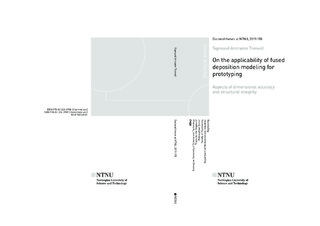On the applicability of fused deposition modeling for prototyping
Doctoral thesis
Permanent lenke
http://hdl.handle.net/11250/2611045Utgivelsesdato
2019Metadata
Vis full innførselSamlinger
Sammendrag
During the last decade, fused deposition modeling (FDM) has managed to become the most used additive manufacturing technology for rapid prototyping. The surge in application of FDM is thought to be due to a severe price drop following the expiration of crucial patents in the decade mid-to-late 2000s. However, the process of compiling strings of molten material into three-dimensional objects has two major pain points; 1) poor dimensional accuracy; and 2) poor structural integrity. Hence, the FDM process is considered a sub-par choice for prototyping. To increase the prototyping applicability of FDM, this thesis aims to improve upon these two aspects. This, by generating knowledge for assessing and improving the part performance, while also generating design tools and knowledge to limit the impact of these major downsides. FDM is a very complex process, with many contextual factors that have implications for the performance of the end-result. The approaches utilized in this thesis are therefore directed towards trying to explore isolated effects and mechanisms, rather than assessing difficult-to-generalize overall performance parameters.
Dimensional accuracy is a well-established area of research, and drivers for defects and inaccuracies can be categorized into STL-conversion, printing fundament, positional accuracy, layer sampling and accuracy of material extrusion, where the contributions of this thesis are focused towards the two latter. The novelties presented here that target these, are; 1) an analysis of layer height and the sampling methods influence on the dimensional accuracy of threaded parts, through a novel method of digital image analysis; and 2) investigation of the performance of pressure advance algorithms, designed to improve the dimensional accuracy in regions of high acceleration/deacceleration of the printer. Findings suggests that both effects have significant influence on the dimensional accuracy of the FDM process.
Structural integrity of FDM is a less mature area of research, where the cause of the subpar performance compared to solid material is often debated. Most of the research within this domain tries to predict part performance based on input parameters, as with conventional material characterization research. This thesis explores an alternative approach, where the mechanical performance is estimated based on experimental investigation of the cellular structure. The novelties connected to this approach, presented in this thesis can be summarized as; 1) integration of statistical perspectives (weakest-link effect) in the assessment of FDM part strength; 2) assessment of through-thickness properties of the mesostructure of FDM, using a novel method for analysis of computed tomography data; and 3) structural analysis of FDM parts using a multiscale simulation approach, currently directed towards linear elastic behavior and strain energy density distribution. Findings suggests that previous work on the structural integrity of FDM parts is highly nongeneralizable, due to a very complex mesostructure and strain energy density distribution.
The concepts presented in this thesis fills in some of the current gaps in the research literature on the performance of FDM parts, and provides models, frameworks and relations that can be utilized in further work.
Består av
Paper 1: Tronvoll, Sigmund Arntsønn; Elverum, Christer Westum; Welo, Torgeir. Dimensional accuracy of threads manufactured by fused deposition modeling. Procedia Manufacturing 2018 ;Volum 26. s. 763-773 https://doi.org/10.1016/j.promfg.2018.07.088 Attribution-NonCommercial-NoDerivatives 4.0 International (CC BY-NC-ND 4.0)Paper 2: Tronvoll, Sigmund Arntsønn; Popp, Sebastian; Elverum, Christer Westum; Welo, Torgeir. Investigating pressure advance algorithms for filament-based melt extrusion additive manufacturing: theory, practice and simulations. - The final published version is available in Rapid prototyping journal 2019 s. 830-839 https://doi.org/10.1108/RPJ-10-2018-0275 This article is published under the Creative Commons Attribution (CC BY 4.0) licence
Paper 3: Tronvoll, Sigmund Arntsønn; Welo, Torgeir; Elverum, Christer Westum. The effects of voids on structural properties of fused deposition modelled parts: a probabilistic approach. The International Journal of Advanced Manufacturing Technology 2018 ;Volum 97.(9-12) s. 3607-3618 https://doi.org/10.1007/s00170-018-2148-x This article is distributed under the terms of the Creative Commons Attribution 4.0 International License CC BY 4.0 (http://creativecommons.org/licenses/by/4.0/)
Paper 4: Tronvoll, Sigmund Arntsønn; Vedvik, Nils Petter; Elverum, Christer Westum; Welo, Torgeir. A new method for assessing anisotropy in fused deposition modeled parts using computed tomography data. - The final published version is available in The International Journal of Advanced Manufacturing Technology 2019 ;Volum 105.(1-4) s. 47-65 https://doi.org/10.1007/s00170-019-04081-7 This article is distributed under the terms of the Creative Commons Attribution 4.0 International License CC BY 4.0 (http://creativecommons.org/licenses/by/4.0/)
